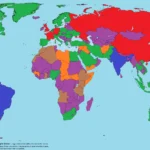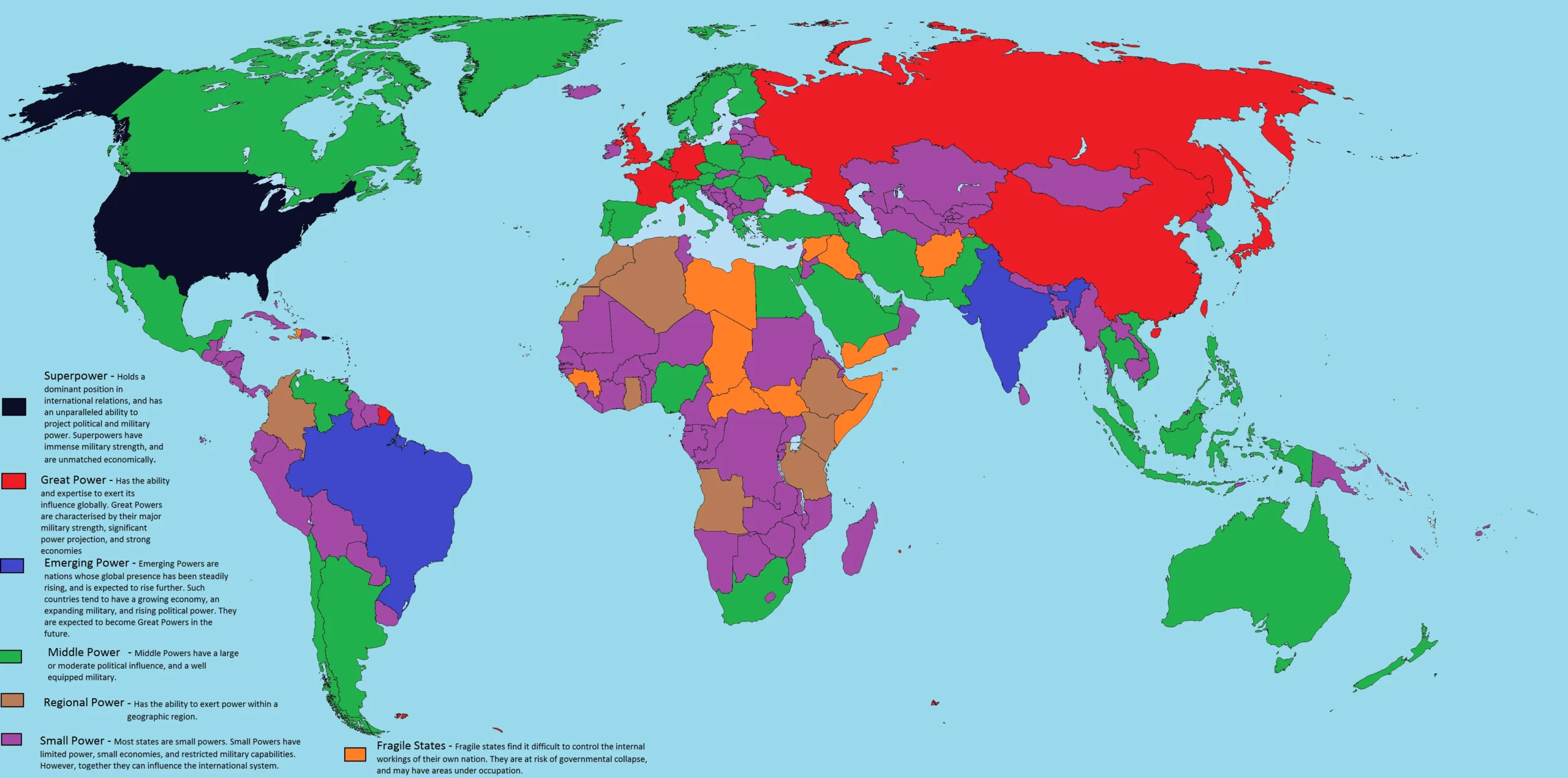What Actually Makes a Country a Global Superpower?
Ever wondered why some countries dominate world news while others barely get mentioned? After studying international relations for years, I’ve noticed that true global superpowers aren’t just big countries – they’re nations that can literally change your life from thousands of miles away.
Think about it: when the US changes its trade policies, your local grocery prices might go up. When China builds new factories, job opportunities in your city could increase. That’s superpower influence in action.
But what exactly separates a superpower from just another large country? Let me break this down based on what I’ve learned from analyzing global politics.
The 4 Essential Elements That Define Modern Superpowers
1. Military Power That Reaches Every Corner of Earth
A real superpower doesn’t just have a strong army – it has the ability to project military force anywhere on the planet within hours. Here’s what this actually means:
Nuclear Arsenal: Not just having nuclear weapons, but having enough to deter any potential threat. The US has about 5,500 nuclear warheads, while Russia maintains roughly 6,000.
Global Military Presence: Superpowers maintain military bases worldwide. The US operates over 800 military installations across 80+ countries. This isn’t just for show – it’s about rapid response capability.
Advanced Defense Technology: Think stealth fighters, aircraft carriers, and satellite surveillance systems. These aren’t just impressive weapons; they’re tools that can monitor and influence global events in real-time.
Military Budget: True superpowers spend more on defense than most countries’ entire GDP. The US military budget exceeds $800 billion annually – more than the next 10 countries combined.
2. Economic Influence That Shapes Global Markets
I remember watching how the 2008 US financial crisis affected job markets in countries that had nothing to do with American banking. That’s economic superpower status – when your economic decisions create ripple effects worldwide.
GDP Dominance: Superpowers typically control 15-25% of global GDP. The US economy represents about 24% of world GDP, while China accounts for approximately 17%.
Currency Power: When other countries prefer your currency for international trade, you’ve achieved economic superpower status. Over 60% of global foreign exchange reserves are held in US dollars.
Global Trade Influence: Superpowers set international trade standards. When the US or China changes trade policies, it affects manufacturing, pricing, and employment worldwide.
Technology Leadership: Modern superpowers lead in innovation. Silicon Valley companies like Apple, Google, and Microsoft shape how billions of people communicate and work daily.
3. Cultural and Political Soft Power
This is perhaps the most interesting aspect of superpower status. It’s not just about forcing others to comply – it’s about making them want to follow your lead.
Entertainment and Media: Hollywood movies, Netflix shows, and American pop music influence global culture. Similarly, Chinese apps like TikTok are reshaping how young people worldwide consume content.
Educational Attraction: Harvard, MIT, and Stanford attract the world’s brightest minds. This brain drain to superpower universities creates lasting influence networks.
Political System Appeal: Other countries often model their institutions after successful superpowers. Many nations have adopted American-style democratic principles or Chinese economic development models.
Language Dominance: English has become the global lingua franca largely due to American superpower status, affecting everything from international business to internet content.
4. Diplomatic Network and International Organization Leadership
Real superpowers don’t just participate in international affairs – they shape the rules of the game.
UN Security Council: Permanent members (US, Russia, China) can veto any international action, giving them disproportionate global influence.
International Financial Institutions: The World Bank and IMF, heavily influenced by the US, can determine economic policies for entire regions.
Alliance Systems: NATO (led by the US) and emerging partnerships (China’s Belt and Road Initiative) create spheres of influence that extend superpower reach.
Historical Evolution: How the Superpower Concept Developed
The British Empire: First Modern Superpower (1815-1914)
Before studying modern superpowers, I always found it fascinating how the British Empire controlled such vast territories with relatively small population. Their secret? Naval dominance and strategic positioning.
The British controlled:
- 25% of global landmass
- 23% of world population
- Major sea routes connecting continents
- Industrial revolution technology
What made Britain special wasn’t just territory size – it was their ability to project power globally through naval supremacy. British pound sterling served as the world’s reserve currency, similar to how the US dollar functions today.
The Cold War Era: Two-Superpower World (1945-1991)
This period taught us that superpowers don’t need to be equal in all aspects. The US was economically stronger, but the Soviet Union could “put up a real fight” militarily and ideologically.
United States Advantages:
- Marshall Plan rebuilt European allies
- Consumer economy attracted global admiration
- Technological innovation (space program, computers)
- Cultural exports (Hollywood, rock music, blue jeans)
Soviet Union Strengths:
- Massive military-industrial complex
- Communist ideology appealed to developing nations
- Space achievements (Sputnik, first human in space)
- Support for anti-colonial movements worldwide
The fascinating thing about this period was how both superpowers had to consider each other’s reactions before making any major international move. This mutual constraint actually prevented many conflicts from escalating.
The Unipolar Moment: American Dominance (1991-2010)
After the Soviet collapse, America achieved something unprecedented in modern history – unchallenged global dominance. Some scholars called this the “unipolar moment” because it seemed temporary even as it happened.
During this period:
- No country could challenge US military supremacy
- American economic model became globally dominant
- English language spread rapidly worldwide
- American technology companies grew into global giants
However, this dominance contained the seeds of its own challenges. Other nations began developing strategies to balance American power, leading to today’s more complex global landscape.
Current Global Superpower Landscape in 2025
United States: Maintaining but Adapting Primacy
Despite facing various challenges over the past two decades, America remains the world’s only true global superpower. Here’s why:
Military Superiority: The US can deploy significant military force to any location within 48 hours. American aircraft carriers patrol every ocean, and the country maintains military partnerships with over 100 nations.
Economic Resilience: Even after the 2008 financial crisis and COVID-19 pandemic, the US economy continues growing. American companies dominate global technology, finance, and entertainment sectors.
Innovation Leadership: Silicon Valley continues producing world-changing technologies. Companies like Tesla, SpaceX, and OpenAI are shaping humanity’s future direction.
Alliance Networks: NATO remains strong, and new partnerships like AUKUS (Australia-UK-US) demonstrate America’s ability to create strategic coalitions.
However, American superpower status faces new challenges:
- Growing national debt affecting fiscal flexibility
- Political polarization reducing international credibility
- Rising competitors challenging US dominance
- Changing global priorities (climate change, cyber security)
China: The Rising Challenger
China’s transformation from isolated communist state to global economic powerhouse represents one of history’s most dramatic changes. But is China actually a superpower yet?
Economic Achievements:
- World’s second-largest economy with $17+ trillion GDP
- Manufacturing hub producing goods for global consumption
- Belt and Road Initiative connecting Asia, Africa, and Europe
- Growing technology sector competing with Western companies
Military Modernization:
- Rapidly expanding naval capabilities in South China Sea
- Advanced missile systems challenging US military dominance
- Growing space program with successful Mars missions
- Cyber warfare capabilities rivaling any nation
Soft Power Expansion:
- Confucius Institutes promoting Chinese language and culture
- TikTok, WeChat influencing global communication patterns
- Chinese students studying at top universities worldwide
- Growing entertainment industry (films, music, gaming)
Limitations:
- Limited global military projection capabilities
- Currency (yuan) not widely used internationally
- Political system doesn’t attract widespread admiration
- Regional tensions limiting diplomatic influence
Russia: Regional Power or Declining Superpower?
Russia presents an interesting case study. During the Cold War, it was clearly a superpower. Today, its status is more debatable.
Remaining Strengths:
- Massive nuclear arsenal rivaling the US
- Energy exports influencing European politics
- Military interventions in Syria, Africa demonstrating global reach
- Cyber capabilities affecting elections and infrastructure worldwide
Significant Weaknesses:
- Economy smaller than several US states
- Population decline affecting long-term power
- Limited cultural influence outside former Soviet regions
- International sanctions restricting economic growth
Most experts classify Russia as a “declining superpower” – still influential but lacking the comprehensive power of true superpowers.
European Union: Collective Superpower Potential
The EU represents an interesting experiment: can separate nations collectively achieve superpower status?
Combined Strengths:
- Largest economy in the world when measured as single unit
- Advanced technology and manufacturing capabilities
- Soft power through democratic values and human rights advocacy
- Regulatory influence affecting global business practices
Critical Weaknesses:
- No unified military command structure
- National interests sometimes conflict with collective goals
- Limited ability to project military power globally
- Political divisions affecting quick decision-making
How Superpowers Actually Affect Your Daily Life
This might surprise you, but superpower decisions probably influenced several aspects of your day before you even finished breakfast. Let me show you how:
Economic Impact on Regular People
Your Job Market: When China builds new factories or America changes trade policies, job opportunities in your region change. The 2018-2020 US-China trade war affected employment from agriculture to manufacturing across dozens of countries.
Product Prices: Superpower economic policies directly affect what you pay for everything from gasoline to electronics. US sanctions on countries can make certain products more expensive globally.
Investment Opportunities: When superpowers perform well economically, global stock markets tend to rise, affecting your retirement savings and investment portfolios.
Technology and Communication
The Apps You Use: TikTok (Chinese), Instagram (American), WhatsApp (American) – superpower companies control how billions communicate daily.
Internet Standards: When America or China sets new technology standards, manufacturers worldwide must comply, affecting the devices you can buy.
Digital Privacy: Superpower surveillance capabilities and privacy laws affect how your personal data is collected and used globally.
Cultural Influences
Entertainment Choices: Netflix originals, Hollywood blockbusters, K-pop (South Korea isn’t a superpower, but benefits from US alliance) – superpower cultural products shape global entertainment preferences.
Language Learning: English dominance due to American superpower status affects which languages are taught in schools worldwide.
Fashion and Trends: From blue jeans to business suits, superpower fashion trends influence clothing styles globally.
Future of Global Superpowers: What’s Coming Next?
Based on current trends and historical patterns, here’s what I predict for the next decade:
The Multi-Polar Future
We’re moving toward a world with multiple superpowers rather than American dominance. This shift creates both opportunities and challenges:
Advantages:
- No single country can dominate global decisions
- Smaller nations have more options for partnerships
- Innovation competition between superpowers benefits everyone
- Reduced risk of global conflicts caused by one nation’s mistakes
Challenges:
- More complex international negotiations
- Potential for proxy conflicts between competing superpowers
- Global problems requiring cooperation become harder to solve
- Economic uncertainty as power balances shift
Emerging Superpower Candidates
India: With 1.4 billion people and growing economy, India could achieve superpower status by 2040-2050. Key advantages include English-speaking population, democratic system, and growing technology sector.
Brazil: Leading South American development and controlling vast natural resources, Brazil has superpower potential if it can achieve political stability and economic growth.
Nigeria: Africa’s most populous country with significant oil resources could emerge as a regional superpower representing African interests globally.
Indonesia: World’s fourth-largest population, strategic location, and growing economy make Indonesia a potential future superpower in Southeast Asia.
New Types of Superpowers
Technology Superpowers: Countries or even companies that dominate crucial technologies (AI, quantum computing, biotechnology) might achieve superpower-like influence without traditional military or economic dominance.
Resource Superpowers: Nations controlling essential resources (rare earth minerals, fresh water, renewable energy) could gain disproportionate global influence as these become more crucial.
Climate Superpowers: Countries that successfully address climate change might gain soft power influence as environmental concerns become more pressing globally.
Regional Powers vs. Global Superpowers: Understanding the Difference
Many people confuse regional powers with global superpowers. Let me clarify this distinction:
Regional Powers
Germany: Dominates European economics but has limited global military projection Japan: Advanced economy and technology but pacifist constitution limits military influence
Iran: Regional Middle Eastern influence but limited global reach South Africa: African continental leadership but limited worldwide influence
True Global Superpowers
Can influence events on every continent simultaneously, maintain global military presence, and shape international institutions. Currently, only the US clearly meets all criteria, with China approaching this status.
How Superpower Competition Affects Global Stability
The Stability-Instability Paradox
Here’s something counterintuitive I’ve learned: superpower competition can actually prevent major wars while increasing smaller conflicts.
Why Major Wars Become Less Likely:
- Nuclear deterrence makes direct superpower conflict too dangerous
- Economic interdependence creates mutual interests in stability
- International institutions provide conflict resolution mechanisms
- Proxy conflicts allow competition without direct confrontation
Why Smaller Conflicts Increase:
- Superpowers support different sides in regional disputes
- Competition for influence creates flashpoints in developing regions
- Cyber warfare allows attacks without triggering full military response
- Economic competition can escalate into trade wars
Current Tension Points
South China Sea: China’s territorial claims conflict with US alliance commitments to regional partners
Ukraine/Russia: NATO expansion eastward conflicts with Russian sphere of influence claims
Taiwan: China considers it a breakaway province while the US maintains strategic ambiguity about defense commitments
Middle East: US and Chinese interests in oil resources and strategic positioning create potential conflicts
Cyber Space: Ongoing attacks between superpower intelligence services create new forms of conflict
The Economics of Being a Superpower
Maintaining superpower status is expensive. Here’s what it actually costs:
Military Expenditures
United States: $801 billion annually (3.5% of GDP) China: $261 billion annually (1.7% of GDP)
Russia: $65 billion annually (4.3% of GDP)
These numbers show that superpowers must dedicate significant resources to maintaining their status, sometimes at the expense of domestic priorities like education or healthcare.
Economic Benefits
However, superpower status also provides economic advantages: Reserve Currency Status: The US benefits from dollar dominance in international trade Technology Export Markets: Superpowers can sell advanced technology at premium prices Resource Access: Superpower influence ensures access to global resources Investment Attraction: International capital flows to superpower markets for stability
The Superpower Trap
Some economists argue that maintaining superpower status can become economically unsustainable. The costs of global military presence, alliance commitments, and technological leadership can exceed the benefits, leading to “imperial overstretch.”
Personal Strategies for Understanding Superpower Impact
Since superpower decisions affect your life, here’s how to stay informed and prepare:
Following Global Trends
Economic Indicators: Watch GDP growth rates, trade balances, and currency fluctuations between major powers Military Developments: Monitor defense spending changes and new military technology deployments Diplomatic Relations: Follow summit meetings, treaty negotiations, and alliance changes Cultural Trends: Observe which countries’ entertainment, technology, and lifestyle choices are gaining global popularity
Investment Implications
Diversification: Don’t put all investments in one superpower’s economy Technology Sector: Monitor which countries are leading in emerging technologies Currency Exposure: Understand how superpower economic policies affect exchange rates Resource Investments: Consider investments in countries that supply essential materials to superpowers
Career Considerations
Language Skills: Learning superpower languages (English, Mandarin) opens global opportunities Technology Expertise: Developing skills in superpower-leading technologies increases career prospects International Experience: Understanding different superpower business cultures provides competitive advantages Geopolitical Awareness: Businesses increasingly value employees who understand global political trends
FAQS
A global superpower is a nation whose immense economic, military, political, and technological capabilities enable it to exert influence worldwide. Key indicators include a high GDP, advanced military strength, diplomatic alliances, soft power (culture, innovation), and global strategic outreach. As of 2025, ranking bodies like U.S. News & World Report emphasize leadership, economic and political influence, strong exports, military power, and alliances
Based on recent 2025 rankings:
The United States leads with its dominant economy (~$30 trillion GDP), unmatched military, and global alliances Forbes IndiaWikipediaTIME.
China follows, leveraging its $19.5 trillion economy, growing AI and tech capabilities, Belt and Road initiative, and vast military Forbes IndiaWikipedia+1.
Other top nations include Russia, United Kingdom, Germany, South Korea, France, Japan, Saudi Arabia, and Israel Forbes IndiaThe Times of IndiaWorld Population ReviewSamoa Global News.
While the U.S. is widely seen as the preeminent superpower, due to its unmatched military budget (37% of global spending), technological innovation, and soft power, many experts recognize a multipolar reality where other nations hold significant global clout World Population ReviewTIMEWikipediaFinancial Times. Countries like China, Russia, and the EU are frequently cited as peer or emerging superpowers Wikipedia+1.
Accordion ContentAccording to the 2025 Global Firepower index:
United States
Russia
China
India
South Korea Global Firepower.
In terms of military expenditures (2024 data from SIPRI / IISS):
U.S.: ~$997 billion (37% of global spending)
China: ~$314 billion
Russia: ~$149 billion
Followed by Germany, India, UK, France, Japan
Accordion ContentScholars often point to China, India, the European Union, and Russia as potential superpowers due to their growing economic, military, and technological influence Wikipedia+1. For instance, China is rapidly closing the gap in scientific leadership with the U.S., particularly in AI and semiconductor research arXiv. India, with its expanding economy and strategic position, is also frequently cited as an emerging contender.











